Archive
- Behind the Screens 9
- Bright Young Things 16
- Colour Palette 64
- Dress Ups 60
- Fashionisms 25
- Fashionistamatics 107
- Foreign Exchange 13
- From the Pages of… 81
- G.U.I.L.T. 10
- Little Trifles 126
- Lost and Found 89
- Odd Socks 130
- Out of the Album 39
- Red Carpet 3
- Silver Screen Style 33
- Sit Like a Lady! 29
- Spin, Flip, Click 34
- Vintage Rescue 20
- Vintage Style 157
- Wardrobe 101 148
- What I Actually Wore 163
In the Mood for Qipaos
 I don’t remember what first inspired my admiration for the traditional Chinese cheongsam, or qipao – very likely a Chinese film – but I am sure it had a lot to do with the sumptuous silk embroidered fabric that many are made from. Many years ago I once owned a beautiful example made from oyster-hued silk, embroidered heavily in red, silver and gold. Unfortunately it was a little small for me, and I stupidly culled it from my wardrobe in a mad fit of minimalism in my late 20s, since I thought I would never wear it. Ever since then I have been looking for a new one.
I don’t remember what first inspired my admiration for the traditional Chinese cheongsam, or qipao – very likely a Chinese film – but I am sure it had a lot to do with the sumptuous silk embroidered fabric that many are made from. Many years ago I once owned a beautiful example made from oyster-hued silk, embroidered heavily in red, silver and gold. Unfortunately it was a little small for me, and I stupidly culled it from my wardrobe in a mad fit of minimalism in my late 20s, since I thought I would never wear it. Ever since then I have been looking for a new one.
 Qipao of the Daoguang Period (1821–1850); Empress Xiaoshen, image from WikipediaThe history of the qipao is long and complicated, and (according to Wikipedia) its origins are controversial. Generally people believe that its origin is in the Qing dynasty (1644–1912), but some scholars argue that in fact the cheongsam was first worn two millennia prior, in a period between the Western Zhou dynasty (1046BC–771BC) and the pre-Qin era (221BC–207BC). Whatever is the truth, the qipao of the Qing dynasty could not be more different from the style common today. It was floor-length and loose, and cut in an A-line that revealed the figure not at all. Only the head, hand and the tips of the toes were visible.
Qipao of the Daoguang Period (1821–1850); Empress Xiaoshen, image from WikipediaThe history of the qipao is long and complicated, and (according to Wikipedia) its origins are controversial. Generally people believe that its origin is in the Qing dynasty (1644–1912), but some scholars argue that in fact the cheongsam was first worn two millennia prior, in a period between the Western Zhou dynasty (1046BC–771BC) and the pre-Qin era (221BC–207BC). Whatever is the truth, the qipao of the Qing dynasty could not be more different from the style common today. It was floor-length and loose, and cut in an A-line that revealed the figure not at all. Only the head, hand and the tips of the toes were visible.
 Chinese singer and actress Zhou Xuan wearing a cheongsam in 1930s in Shanghai; C.H. Wong Photo Studio; Image from WikipediaIn China, women’s liberation had as much effect as it had in other parts of the world at the turn of the 20th century, and the Republican period (1912–1949) is known as the golden age of the cheongsam. It is from this era that the cheongsam as we know it took form. Along with the ending of traditional foot binding, women began to bob their hair, and took to wearing this formerly exclusively masculine attire: one-piece clothing called Changshan or changpao. Now, too, the style was influenced by western fashion – the body-skimming bias-cuts popularised by Hollywood stars – hugging the figure, with hemlines gradually rising and formerly merely practical splits running much higher.
Chinese singer and actress Zhou Xuan wearing a cheongsam in 1930s in Shanghai; C.H. Wong Photo Studio; Image from WikipediaIn China, women’s liberation had as much effect as it had in other parts of the world at the turn of the 20th century, and the Republican period (1912–1949) is known as the golden age of the cheongsam. It is from this era that the cheongsam as we know it took form. Along with the ending of traditional foot binding, women began to bob their hair, and took to wearing this formerly exclusively masculine attire: one-piece clothing called Changshan or changpao. Now, too, the style was influenced by western fashion – the body-skimming bias-cuts popularised by Hollywood stars – hugging the figure, with hemlines gradually rising and formerly merely practical splits running much higher.
While the Communist Revolution virtually ended the popularity of the cheongsam, Shanghainese emigrants and refugees took the fashion with them to Hong Kong and Taiwan, and kept the style alive there.
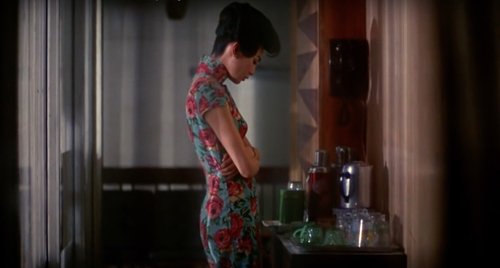 Maggie Cheung in Wong Kar Wai's In the Mood for Love, 2000
Maggie Cheung in Wong Kar Wai's In the Mood for Love, 2000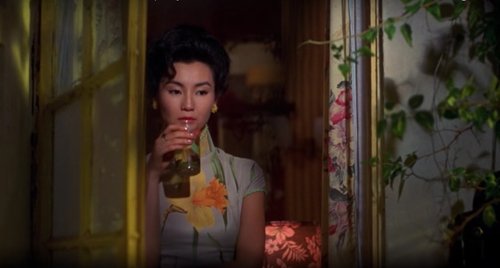 Maggie Cheung in Wong Kar Wai's In the Mood for Love, 2000Wong Kar Wai’s beautiful and bitter-sweet film In the Mood for Love is based on the Shanghai diaspora from the Revolution, and is set in Hong Kong in 1962. Its heroine, played by Maggie Cheung, wears a gorgeous collection of cheongsams – I remember seeing the film in the cinema when it was released in 2000, and I found the costumes no less breathtaking than the cinematography.
Maggie Cheung in Wong Kar Wai's In the Mood for Love, 2000Wong Kar Wai’s beautiful and bitter-sweet film In the Mood for Love is based on the Shanghai diaspora from the Revolution, and is set in Hong Kong in 1962. Its heroine, played by Maggie Cheung, wears a gorgeous collection of cheongsams – I remember seeing the film in the cinema when it was released in 2000, and I found the costumes no less breathtaking than the cinematography.
 I was very excited when I finally found my new cheongsam, on my Day of Yellow Bonanza, the miraculous Saturday a few months ago when I found several yellow items scattered in thrift stores across Melbourne, including a 1940s ballgown. The cheongsam is made from a luminous pale-yellow brocade of chrysanthemums, which is a popular flower in Chinese culture. It is one of four seasonal symbolic flowers representing autumn, and is also the flower of the ninth moon. The dress probably dates from the 60s, and the fabric is rayon. It actually needs to be tailored to fit me a bit better, which is why you see me with hands on waist to disguise the bagginess there. I am wearing it with a pair of patent yellow stilettos by Aldo, also found in a thrift store.
I was very excited when I finally found my new cheongsam, on my Day of Yellow Bonanza, the miraculous Saturday a few months ago when I found several yellow items scattered in thrift stores across Melbourne, including a 1940s ballgown. The cheongsam is made from a luminous pale-yellow brocade of chrysanthemums, which is a popular flower in Chinese culture. It is one of four seasonal symbolic flowers representing autumn, and is also the flower of the ninth moon. The dress probably dates from the 60s, and the fabric is rayon. It actually needs to be tailored to fit me a bit better, which is why you see me with hands on waist to disguise the bagginess there. I am wearing it with a pair of patent yellow stilettos by Aldo, also found in a thrift store.
Read more about the history of the qipao here, and about Maggie Cheung’s wardrobe for the sublime film In the Mood for Love here – I am inspired to watch it again.
 Maggie Cheung in Wong Kar Wai's In the Mood for Love, 2000
Maggie Cheung in Wong Kar Wai's In the Mood for Love, 2000
Photos: August 2018
Polka Dot Homage
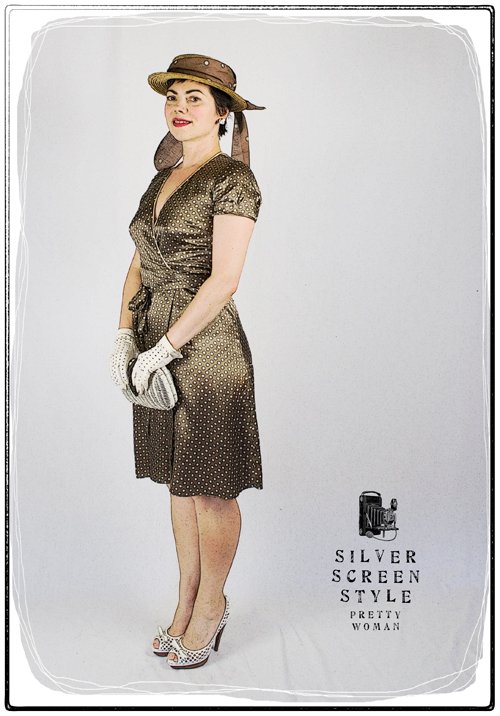 Polka dots are a perennial print favourite. Even if they’re not precisely in fashion, they will never look outré. They are a classic pattern, especially in black and white, or white dots with some other neutral, such as navy or brown – even red could be almost classed as a neutral.
Polka dots are a perennial print favourite. Even if they’re not precisely in fashion, they will never look outré. They are a classic pattern, especially in black and white, or white dots with some other neutral, such as navy or brown – even red could be almost classed as a neutral.
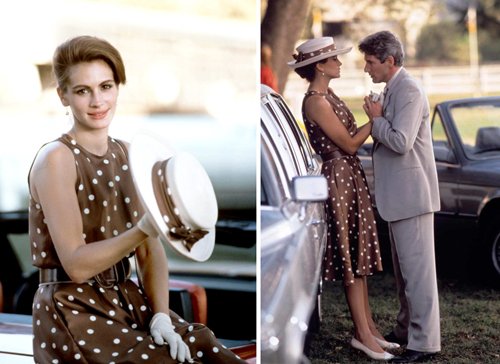 Julia Roberts and Richard Gere in ‘Pretty Woman’, 1990One of the most iconic polka dot outfits I can think of is Julia Robert’s brown and white dress she wore to the polo match in the 1990 film Pretty Woman. Who could forget that one? It was memorable because it was such a elegant and classic outfit unlike many of the others, which were trendier – and not least because the scenes between Vivian and Edward held so much charm. I recently watched the film again for the first time in years, and that is definitely my favourite outfit of Vivian’s – not at all the red dress she wears to the opera, which is cited all over the internet as iconic.
Julia Roberts and Richard Gere in ‘Pretty Woman’, 1990One of the most iconic polka dot outfits I can think of is Julia Robert’s brown and white dress she wore to the polo match in the 1990 film Pretty Woman. Who could forget that one? It was memorable because it was such a elegant and classic outfit unlike many of the others, which were trendier – and not least because the scenes between Vivian and Edward held so much charm. I recently watched the film again for the first time in years, and that is definitely my favourite outfit of Vivian’s – not at all the red dress she wears to the opera, which is cited all over the internet as iconic.
Quite a while back I came across a brown polka dot dress completely by chance in an op shop. It wasn’t the same as Vivian’s dress – it was a silk wrap dress, in a different shade of brown – but it certainly reminded me of it, although I do prefer the more cinnamon shade of brown in her dress.
 I am accessorising it with a vintage boater sporting a polka dot tie (not original to the hat); vintage 50s broderie anglaise gloves; a vintage Laura Ashley cane bag; and Italian woven leather heels. In the film, Vivian’s shoes were of an appropriate heel height for walking on a playing field, unlike mine. I know nothing about the sport, but if I ever attend a match, at least I’ll have an outfit!
I am accessorising it with a vintage boater sporting a polka dot tie (not original to the hat); vintage 50s broderie anglaise gloves; a vintage Laura Ashley cane bag; and Italian woven leather heels. In the film, Vivian’s shoes were of an appropriate heel height for walking on a playing field, unlike mine. I know nothing about the sport, but if I ever attend a match, at least I’ll have an outfit!
Photos: March 2017
Liza Doolittle Day

Liza Doolittle Day
It’s Eliza Doolittle Day, did you know? It’s a long time since I have seen the film My Fair Lady, I must admit, and the thing I love most about it is that it’s Audrey Hepburn playing the title role, and Cecil Beaton designed the costumes.
A while back I was reminded that in a scene where Eliza daydreams about meeting the king, she sings these words:
One evening the king will say:
“Oh, Liza, old thing,
I want all of England your praises to sing.
Next week on the twentieth of May
I proclaim Liza Doolittle Day!
All the people will celebrate the glory of you
And whatever you wish and want I gladly will do.”
At that point in the story, Eliza wished ’Enry ’Iggins dead!
However, my sartorial homage here is to her famous black and white racing outfit. I’m wearing a mix of vintage and more contemporary items. The screw-on earrings are 40s; the gloves – trimmed in bows – are 50s; the skirt and belt 80s, and the Edwardian hat is from the late 90s (the milliner was inspired by Kate Winslet’s hat at the start of the film Titanic). The jabot and striped shirt are more modern numbers.
Here’s to you Liza!
Photo: May 2018
Star Wars Day
 Padmé Amidala, Queen of Naboo, would like to wish you Happy Star Wars Day! Granted, she doesn’t look very happy but lots of horrible things happened to her: (spoiler alert) her planet was being invaded, her husband turned into Darth Vader, and finally she died in childbirth.
Padmé Amidala, Queen of Naboo, would like to wish you Happy Star Wars Day! Granted, she doesn’t look very happy but lots of horrible things happened to her: (spoiler alert) her planet was being invaded, her husband turned into Darth Vader, and finally she died in childbirth.
I wore this costume, remarkably cobbled together from items of clothing I actually own, to my work’s Christmas party last year. I work at a theatre, so as you can imagine, most people go all-out for our annual dress-up and try to out-do one another with mostly stellar results. Every year we are given a theme, and last year it was ‘Out of this World’. I immediately decided on the Queen of Naboo, with one restriction laid on myself: to create the costume without spending any (or very little) money.
I knew the most difficult part to recreate would be the hair, and after very little searching for Geisha-style wigs I quickly discovered what a paucity of options there were on offer. I decided that I would have to be creative.
While I left that on the backburner, I turned my attention to the other parts of the costume. You might have thought the headdress would be a stumbling block, but that was easy – naturally I had an enormous feathered hat (once featured in Australian Vogue magazine in the 90s) on hand.
You might have thought the headdress would be a stumbling block, but that was easy …
As for the rest: the gorgeous Chinese silk lace blouse was a recent purchase in a thrift store, and the vintage kimono was a souvenir I had bought in Vietnam many years ago from an antique store. The leather obi I bought new when obis were all the rage in mainstream fashion a decade or two ago.
Two vintage silk skirts layered provided the sumptuousness of Queen Amidala’s wardrobe, and were also purchases from thrift stores. The shot-silk blue skirt is probably 80s, and the red skirt (beautifully constructed) is I think a 70s number. Underneath I wore white socks and black leather ballet flats.
 Queen Amidala’s makeup is iconic, and immediately pulls the whole ensemble together – that’s where I spent a small portion of my $15 total, on white face makeup. As for the wig: I decided to utilise a pair of black wool tights, stuffed with polyester hobby filler (the other portion of my spending) and twisted into a fanciful shape. I tried ordinary opaque tights, but the lighter fibres proved to be transparent, so I had to bring out the big guns. The wig is quite heavy and clumsy, and the hat precariously balanced, but good enough for the few hours of a costume party. (That’s when a queenly deportment comes in handy – no slouching!)
Queen Amidala’s makeup is iconic, and immediately pulls the whole ensemble together – that’s where I spent a small portion of my $15 total, on white face makeup. As for the wig: I decided to utilise a pair of black wool tights, stuffed with polyester hobby filler (the other portion of my spending) and twisted into a fanciful shape. I tried ordinary opaque tights, but the lighter fibres proved to be transparent, so I had to bring out the big guns. The wig is quite heavy and clumsy, and the hat precariously balanced, but good enough for the few hours of a costume party. (That’s when a queenly deportment comes in handy – no slouching!)
I caused a sensation at the office party; one of the most amusing aspects was having to move sideways through the crowds, lest I took someone’s eye out with my hat! There was also a couple of Darth Vaders and a Boba Fett, so there was plenty of opportunity for Imperial high jinks.
May the Fourth be with you!
Photos: Yesterday
~
Scroll down for some party pics.
 Getting ready in the office bathroom (you can see the rear view in the mirror).
Getting ready in the office bathroom (you can see the rear view in the mirror). 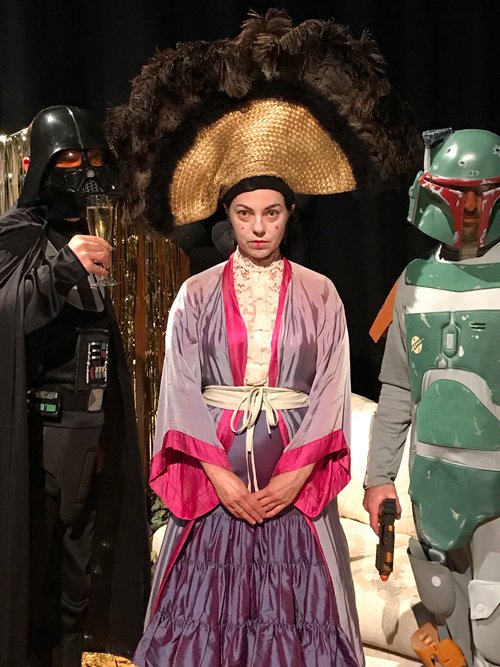 Queen Amidala always looks so solemn, but her planet IS being invaded after all!
Queen Amidala always looks so solemn, but her planet IS being invaded after all!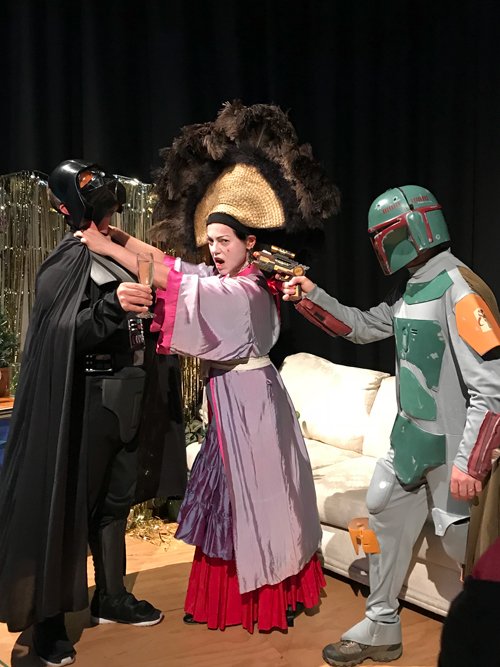 Oh, Anakin! How could you!?
Oh, Anakin! How could you!? 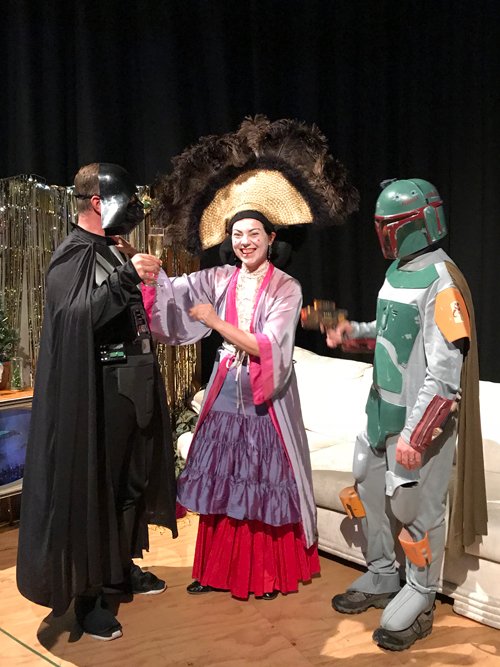 Apparently I don't know my own strength – I actually nearly strangled poor Darth. Luckily he was forgiving, or maybe that was the sparkling wine.
Apparently I don't know my own strength – I actually nearly strangled poor Darth. Luckily he was forgiving, or maybe that was the sparkling wine.
Venus x Abigail
 There is such a joy in op-shopping when one stumbles upon a rare and fabulous find such as this 1970s Regency-inspired maxi dress with shirred bodice in tomato red with slit bell sleeves featuring prints of a hybrid Botticelli Venus-Flora figure. (No fashion journalist could ever have dreamed of penning such a sentence!)
There is such a joy in op-shopping when one stumbles upon a rare and fabulous find such as this 1970s Regency-inspired maxi dress with shirred bodice in tomato red with slit bell sleeves featuring prints of a hybrid Botticelli Venus-Flora figure. (No fashion journalist could ever have dreamed of penning such a sentence!)
I actually must credit a Vinnies staff member for bringing this priceless treasure to my attention, for in my excitement at finding another 70s dress (hand crocheted turquoise) I had unbelievably missed spotting this on the same rack! The lady declared it a quintessential 70s dress, and reminisced how she herself had worn such garments when she was young to her high school prom.
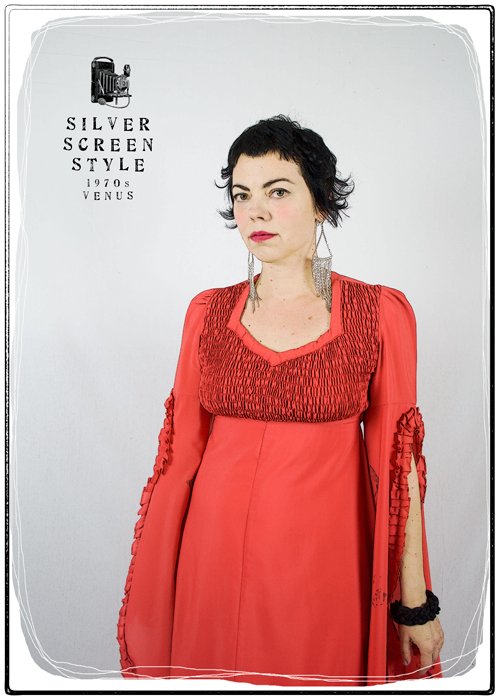 Someone whose chest was too ample to close the zip had actually altered the dress. The back had been opened up and sewn flat, and two sets of ties had been added to the back. I think the fabric for them had been cut off the hem of the dress, as the hem is not very well hand-stitched. When I got it home I unpicked all the stitching, hoping that it would fit me, and fortunately it does.
Someone whose chest was too ample to close the zip had actually altered the dress. The back had been opened up and sewn flat, and two sets of ties had been added to the back. I think the fabric for them had been cut off the hem of the dress, as the hem is not very well hand-stitched. When I got it home I unpicked all the stitching, hoping that it would fit me, and fortunately it does.
Of course the caped sleeves are mind-blowingly awesome, and I also love the little peaked shoulders, but the pièce de résistance is the printed lady. I immediately recognised her as Sandro Botticelli’s Flora, the goddess of flowers and the season of spring depicted in the painting Primavera (painted in the late 1470s or early 1480s) – she’s the one casting flowers about out of the folds of her robe. But what is even funnier, I realised later, is that the head is that of Venus, flipped around, from another of Botticelli’s paintings, The Birth of Venus (1485)! (Was this the designer’s answer to avoiding copyright infringement?)
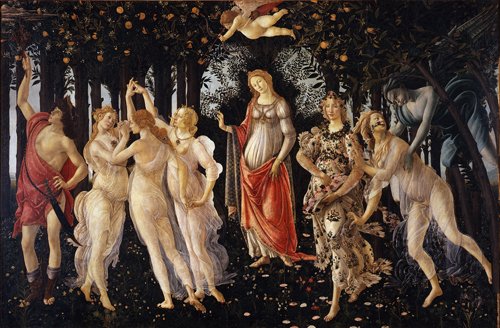 Primavera, Sandro Botticelli (late 1470s or early 1480s)
Primavera, Sandro Botticelli (late 1470s or early 1480s) The Birth of Venus, Sandro Botticelli (1485)The label is Clementine, and states ‘dry clean only’, at which I scoffed as I laid it into a laundry tub of water to hand wash. It is probably a poly crepe, or at best, part rayon as well.
The Birth of Venus, Sandro Botticelli (1485)The label is Clementine, and states ‘dry clean only’, at which I scoffed as I laid it into a laundry tub of water to hand wash. It is probably a poly crepe, or at best, part rayon as well.
The dress really comes to life in movement. I am planning to wear it to the opening night of Abigail’s Party, a 70s period next on stage at the theatre I work at. It is exactly like something the titular character might wear herself. I shall have to make sure to swish and swan about just like her.
 A scene from Abigail's Party (1977), Mike Leigh's film of his own original stage play (Abigail is wearing the red dress)
A scene from Abigail's Party (1977), Mike Leigh's film of his own original stage play (Abigail is wearing the red dress)
Photos: Yesterday (March 2018)


